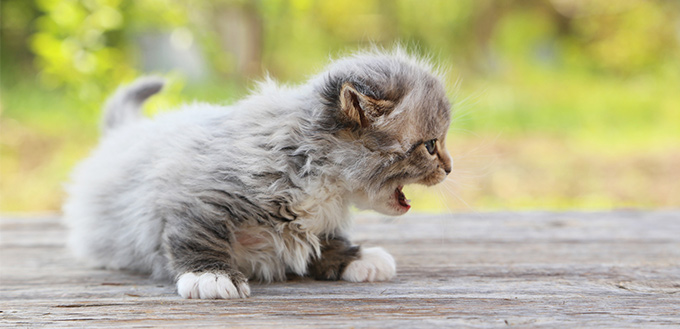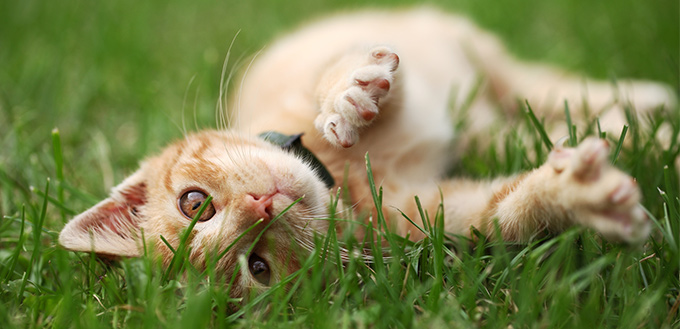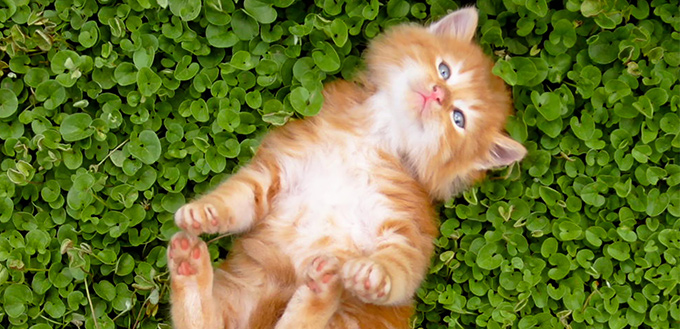Whether or not you’re aspiring to become like Jackson Galaxy or renowned cat behaviorist Mieshelle Nagelschneider, you know that communicating with your feline friend is an important aspect of pet parenthood. Cats have a very unique set of behaviors that comprise their ability to communicate either with fellow cats or to their respective owners. Learning what your cat is trying to say, through its behavior and body language, is crucial to providing cat-appropriate care.

Vocalizations
Just as dogs bark, cats can be a noisy lot, too, especially during mating. Unlike dogs, however, cats have a fascinating array of vocalizations that include the ubiquitous ‘meow’ to the spine-raising ‘hiss’ or even the annoying ‘howl’. But, what do these vocalizations mean anyway?
- Meow
“Meow” is, without a doubt, the most common vocalization heard among cats. Unfortunately, because it is so common it can mean a lot of things, too. For instance, a short and solid ‘meow’ is more like a cat’s way of objecting to something or it could also mean that it is stating a ‘fact’. It can also be interpreted as the cat’s way of commanding you to give it something or to do something for the cat such as giving it more food or giving it its favorite toy. A ‘meow’ that is soft and long can mean more like a greeting in pretty much the same way as you would say ‘hello’ to a dear friend as opposed to a total stranger. Some cats are also known to ‘meow’ while going from room to room in your house.
Related Post: Best Cat Toys
- Purr
The classic ‘purr’ is usually interpreted as a good sign, especially if it is vocalized in conjunction with rubbing its body on your feet. It usually means ‘contentment’ or a sense of fulfillment or happiness. However, it is not unusual that some cats also ‘purr’ when they are sick or anxious. Cat behaviorists say this is more like thumb-sucking in young children. Cats purr when they are feeling stressed as a means of comforting themselves.
- Trills and Chirps
If you see a mother cat, it will usually elicit chirps and trills as a means of telling its kittens to follow mommy. These rather high-pitched, almost-vibratory vocalizations are produced to make someone or another cat to follow the one issuing the ‘command’.
- Hiss, Spit, or Growl
Cats that are annoyed, angry, aggressive, or even frightened tend to growl, spit, or hiss. You clearly don’t want to go anywhere near this cat especially if you see other body language such as having its back arched and its fur standing up like porcupine quills. Stand back! That’s the message.
- Howl or Yowl
Howling or yowling is a cat’s way of telling you that it is in distress, although it is often heard among unsprayed and unneutered cats as an important part of their mating behavior. Older cats with dementia are also known to howl because of disorientation. If you have a cat and it’s nowhere its cycle you should always make an attempt to find out where your cat is. The howl is its way of saying ‘help!’

What Its Body Tells You
Just like humans and dogs, the way a cat moves its body can say a lot of things. Learning how to decipher these bodily movements or body language can help improve your understanding of cat behavior.
- Watch the Tail
Cats’ tails can say a lot of things. A cat that is cheerful, approachable, and happy usually has its tail standing up. On the contrary, a cat whose tail is lowered is often a cat that feels threatened of scared.
Cats moving their tails very fast in a back and forth motion are a sure sign that they are not in a good mood to play. This is the direct opposite of a dog wagging its tail as if it is actually enticing you to play with it. A cat that waves its tail frantically is telling you to back off.
If the tail movement is rather slow, it means the cat is trying to figure out something. Maybe it is trying to decide whether to let you approach it or not. If ever you see a cat with its now-iconic Halloween tail, don’t make any attempts to go near it. It’s trying to appear scary.
- Ears Say a Lot
The way a cat moves its ears can mean a lot of things, too. If the ears are positioned forward, it means the cat is all for a good time. It may also mean that it is happy and content. If its ears are standing straight up for the sky, it is usually in a hyper-alert state. It’s trying to pick up a lot of signals from its environment in the same way as a dog’s erect ears will mean the same thing – vigilance.
If the cat’s ears are turned backwards, it’s often an indication of overstimulation or a feeling of irritation. It can also mean that the cat is anxious or nervous about something. This is almost the same with cat ears that are turned sideways. If you notice your cat’s ears to be in any of these positions, you’d better keep your distance.
There’s one sure sign that a cat doesn’t want to be touched or disturbed, and that would be its ears drawn all the way back and flat against its head. This is a sign of defensiveness, aggression, and anger. Whatever you do, it’s best not to mess with this kitty.
- The Eyes that Talk
They say that a cat’s eye is like a dagger that can pierce through your heart. True enough it’s often been depicted in media as the single most important indicator of a cat’s intentions. While they may be beautiful especially when they are as round as Puss in Boots’ begging eyes, they can mean a variety of things, too.
Stimulated, scared, or surprised cats will typically have their pupils dilated. This is believed to be a natural response of animals in situations where they need to gather as much information as possible. The wider the pupils of the cat’s eyes, the more fearful it usually is. It’s like the pupillary reaction in humans. If anxious, the pupils also grow large.
When the pupils are constricted or become narrower in diameter, it usually indicates tension or aggression in the cat. The reason for the pupillary constriction is to increase its visual acuity or focus on a certain ‘target’. This allows cats to focus on something really important. However, cat behaviorists say that this observation should always be taken in the light of prevailing circumstances.
We are always told to establish and maintain eye contact with the persons we are having a conversation with. Do that to a cat and it’s like inviting trouble. Cats don’t like being stared down. They feel uncomfortable. It’s as if they are being challenged. That’s why if you see your cat giving you the blink-less stare it only means one thing: it’s challenging you. The question now is would you accept the challenge?
The opposite of the cat’s challenging stare is the slow-blinking eyes. Animal behaviorists call it the fluttering blink and is often a means of communicating a cat’s affection. When a cat slowly blinks at a human, it is effectively communicating trust. As a pet parent, you should recognize this and reciprocate by blinking, too.
A cat with its eyes half-closed doesn’t mean that it’s already on its way to becoming Garfield. Far from it. Cats that have droopy eyelids often indicate a trusting and relaxed kitty. When displayed with other unique feline behaviors that indicate trust, you’ll know that this is the perfect moment to initiate bonding activities with your cat.
- Body position
In addition to the movement of the tail, eyes, and ears of your cat, the overall movement or positioning of its body can meld all of these behaviors together.
If the cat’s back is arched it can mean two things, depending on whether its fur is also standing like porcupine quills or not. If the fur is also standing upright, the cat is usually considered as angry or frightened. If the fur is flat on its arched back it is actually in need of your touch and would love very much to be cuddled.
If your cat is lying on its back, it can also mean two things depending on whether it is growling or purring. Obviously, if it is growling it means your cat is upset and can strike anytime. If it is purring while lying on its back, it is in its most relaxed state.

Deciphering Common Cat Behaviors
The different positions and movements of a cat’s body as well as the accompanying vocalizations can help you decipher many of the different behaviors in cats. Here are some of the most common cat behaviors you really need to be aware of and what they may mean.
- Displaying the Tummy
As we mentioned in the preceding section there are two possibilities why cats may want to display their tummies. The first is related to a very relaxed, very calm, and very content cat. This is especially true if the ears, eyes, and tails are also displaying the same behavior. It simply means that you can easily walk up to your cat and give it a cuddle.
However, cats that have been cornered or feel they cannot escape typically assume the belly up position, too. This time you’ll see its sharp teeth and its claws fully extended like Wolverine’s. Listen to it and if you hear growling instead of purring, you’d better back off.
- The Halloween Pose
The classic Halloween pose of cats is often mistaken as a frightened cat. As a matter of fact, this behavior is typically seen in cats that feel threatened. They assume the archetypal stance – arched back, claws fully extended, fur along its back standing upright, and an unmistakable bottle brush-like posture of its tail – in an attempt to look bigger than it really is. It’s like the porcupine that raises all of its quills in an effort to dissuade larger predators from carrying out their intentions. If you see this pose in your cat, don’t mess with it.
- Rubbing
There are two schools of thought when it comes to the rubbing behavior of cats. On one side of the spectrum are those that say the rubbing is more an indication of a cat’s affection, trust, and passion for the pet parent being rubbed against.
The other notion is that rubbing is a cat’s way of marking its ‘property’ or ‘territory’. Many felines are observed to rub their bodies against toys, chairs, and almost everything and anything in sight. The behavior is their way of saying that such a particular item is ‘theirs’.
- Making Biscuits
In case you haven’t noticed, most cats actually work their paws on soft, cushiony surfaces as if they are kneading dough. Experts believe that this is a holdover behavior from the cat’s kittenhood. In order to express more milk from their mother cat’s breasts, kittens will have to ‘knead’ or push against the breast tissues to help bring out more milk. Technically, it is a behavior that often indicates happiness and a feeling of contentment for the cat.
- The Flehmen Response
Aside from their nose, cats also use another body organ to gather more olfactory information about certain things in the environment. This body organ is called the Jacobson’s organ and it is located right on the roof of the cat’s mouth. The Jacobson’s organ is believed to be connected to the cat’s olfactory bulbs in the nose.
When a cat smells something really interesting, it will usually lift its head and slightly open its mouth. This is to allow the Jacobson’s organ to receive the scent of the ‘item’ which is then integrated with the olfactory information from the cat’s nose. So don’t be surprised if your cat smells something and then all of sudden lifts its head and opens its mouth before squinting its eyes. It just means it finds that ‘thing’ really interesting.
There are many more behaviors and body language that cats use to communicate with other cats and with their human pet parents. Learning the most common ones should help you gain a better understanding of your cat’s unique personality as a pet.
Sources:
- Cat Body Language: Communication and Expression, Best Friends Animal Society
- Dr. H. Ellen Whiteley, How to Solve Cat Behavior Problems, HowStuffWorks
- Rebekah Kuschmider, How to Read Your Cat’s Body Language, WebMD







Valuable piece! Cats can say a lot with the way their ears, hairs, and tail are positioned. If you want to understand your cat more, learn cat’s tail sign language. Besides their tail language, felines do not possess a vocabulary and use the same kind of sounds, then you have got it wrong. Cats get vocal with different kinds of sounds and you need to understand cat sounds meaning to figure out what your kitty is trying to say.